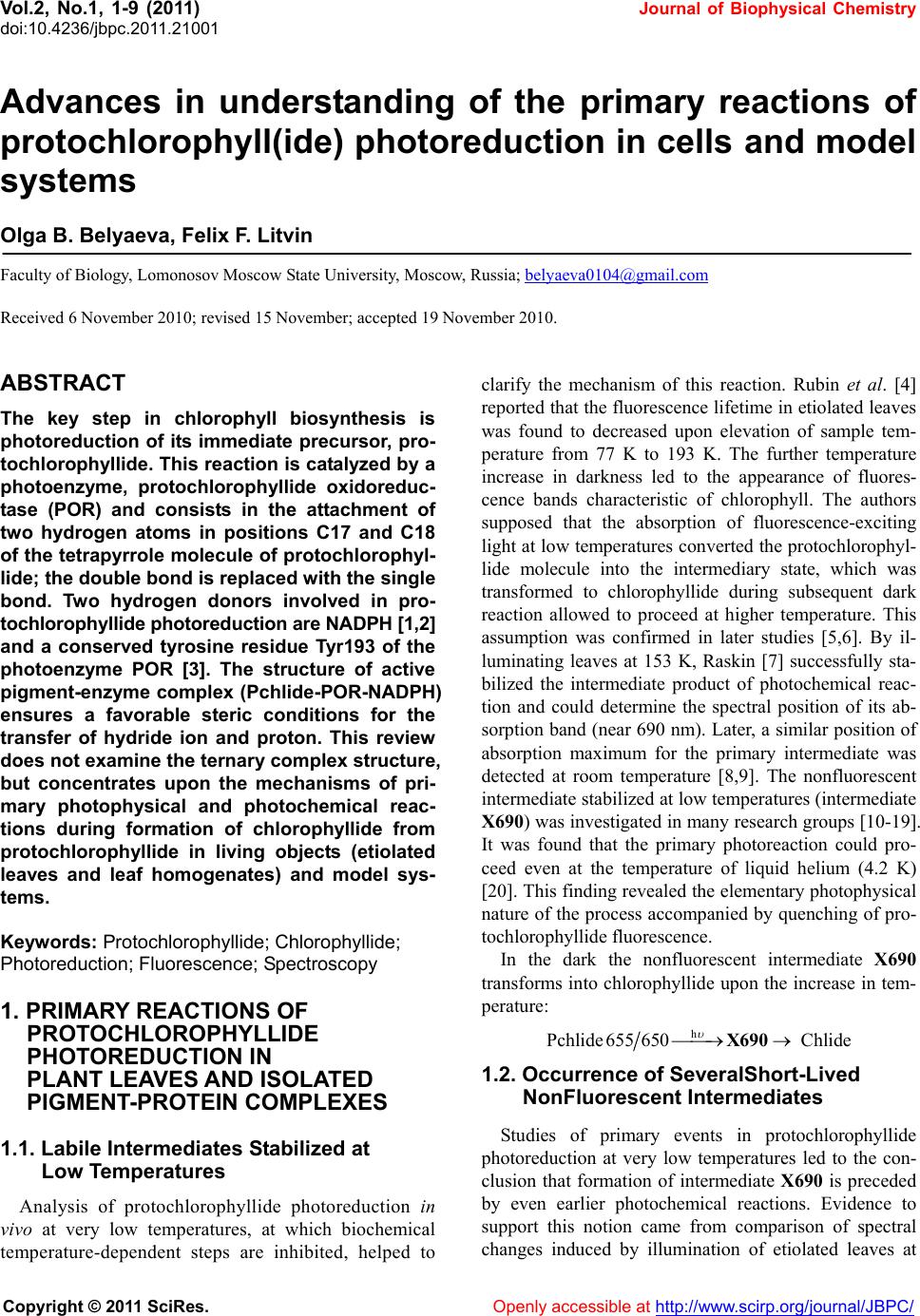 Vol.2, No.1, 1-9 (2011) doi:10.4236/jbpc.2011.21001 Copyright © 2011 SciRes. Openly accessible at http://www.scirp.org/journal/JBPC/ Journal of Biophysical Chemistry Advances in understanding of the primary reactions of protochlorophyll(ide) photoreduction in cells and model systems Olga B. Belyaeva, Felix F. Litvin Faculty of Biology, Lomonosov Moscow State University, Moscow, Russia; belyaeva0104@gmail.com Received 6 November 2010; revised 15 November; accepted 19 November 2010. ABSTRACT The key step in chlorophyll biosynthesis is photoreduction of its immediate precursor, pro- tochlorophyllide. This reaction is catalyzed by a photoenzyme, protochlorophyllide oxidoreduc- tase (POR) and consists in the attachment of two hydrogen atoms in positions C17 and C18 of the tetrapyrrole molecule of protochlorophyl- lide; the double bond is replaced with the single bond. Two hydrogen donors involved in pro- tochlorophyllide photoreduction are NADPH [1,2] and a conserved tyrosine residue Tyr193 of the photoenzyme POR [3]. The structure of active pigment-enzyme complex (Pchlide-POR-NADPH) ensures a favorable steric conditions for the transfer of hydride ion and proton. This review does not examine the ternary complex structure, but concentrates upon the mechanisms of pri- mary photophysical and photochemical reac- tions during formation of chlorophyllide from protochlorophyllide in living objects (etiolated leaves and leaf homogenates) and model sys- tems. Keywords: Protochlorophyllide; Chlorophyllide; Photoreduction; Fluorescence; Spectroscopy 1. PRIMARY REACTIONS OF PROTOCHLOROPHYLLIDE PHOTORE DUCTION IN PLANT LEAVES AND ISOLATED PIGMENT-PROTEIN COMPLEXES 1.1. Labile Intermediates Stabilized at Low Temperatures Analysis of protochlorophyllide photoreduction in vivo at very low temperatures, at which biochemical temperature-dependent steps are inhibited, helped to clarify the mechanism of this reaction. Rubin et al. [4] reported that the fluorescence lifetime in etiolated leaves was found to decreased upon elevation of sample tem- perature from 77 K to 193 K. The further temperature increase in darkness led to the appearance of fluores- cence bands characteristic of chlorophyll. The authors supposed that the absorption of fluorescence-exciting light at low temperatures converted the protochlorophyl- lide molecule into the intermediary state, which was transformed to chlorophyllide during subsequent dark reaction allowed to proceed at higher temperature. This assumption was confirmed in later studies [5,6]. By il- luminating leaves at 153 K, Raskin [7] successfully sta- bilized the intermediate product of photochemical reac- tion and could determine the spectral position of its ab- sorption band (near 690 nm). Later, a similar position of absorption maximum for the primary intermediate was detected at room temperature [8,9]. The nonfluorescent intermediate stabilized at low temperatures (intermediate X690) was investigated in many research groups [10-19]. It was found that the primary photoreaction could pro- ceed even at the temperature of liquid helium (4.2 K) [20]. This finding revealed the elementary photophysical nature of the process accompanied by quenching of pro- tochlorophyllide fluorescence. In the dark the nonfluorescent intermediate X690 transforms into chlorophyllide upon the increase in tem- perature: h Pchlide655650 Chlide υ ⎯⎯→→X690 1.2. Occurrence of SeveralShort-Lived NonFluorescent Intermediates Studies of primary events in protochlorophyllide photoreduction at very low temperatures led to the con- clusion that formation of intermediate X690 is preceded by even earlier photochemical reactions. Evidence to support this notion came from comparison of spectral changes induced by illumination of etiolated leaves at 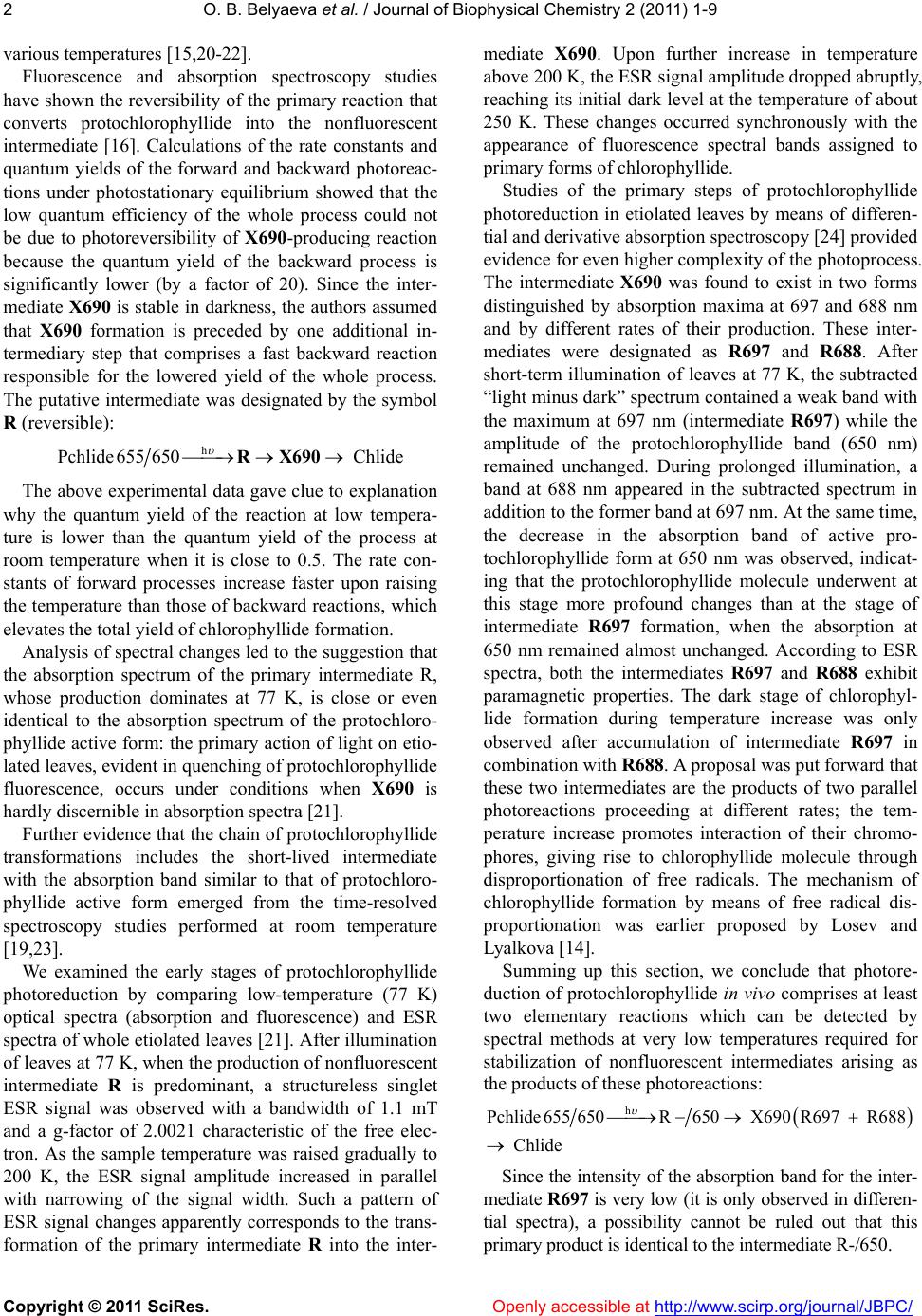 O. B. Belyaeva et al. / Journal of Biophysical Chemistry 2 (2011) 1-9 Copyright © 2011 SciRes. Openly accessible at http://www.scirp.org/journal/JBPC/ 2 various temperatures [15,20-22]. Fluorescence and absorption spectroscopy studies have shown the reversibility of the primary reaction that converts protochlorophyllide into the nonfluorescent intermediate [16]. Calculations of the rate constants and quantum yields of the forward and backward photoreac- tions under photostationary equilibrium showed that the low quantum efficiency of the whole process could not be due to photoreversibility of X690-producing reaction because the quantum yield of the backward process is significantly lower (by a factor of 20). Since the inter- mediate X690 is stable in darkness, the authors assumed that X690 formation is preceded by one additional in- termediary step that comprises a fast backward reaction responsible for the lowered yield of the whole process. The putative intermediate was designated by the symbol R (reversible): h Pchlide655650 Chlide υ ⎯⎯→→ →R X690 The above experimental data gave clue to explanation why the quantum yield of the reaction at low tempera- ture is lower than the quantum yield of the process at room temperature when it is close to 0.5. The rate con- stants of forward processes increase faster upon raising the temperature than those of backward reactions, which elevates the total yield of chlorophyllide formation. Analysis of spectral changes led to the suggestion that the absorption spectrum of the primary intermediate R, whose production dominates at 77 K, is close or even identical to the absorption spectrum of the protochloro- phyllide active form: the primary action of light on etio- lated leaves, evident in quenching of protochlorophyllide fluorescence, occurs under conditions when X690 is hardly discernible in absorption spectra [21]. Further evidence that the chain of protochlorophyllide transformations includes the short-lived intermediate with the absorption band similar to that of protochloro- phyllide active form emerged from the time-resolved spectroscopy studies performed at room temperature [19,23]. We examined the early stages of protochlorophyllide photoreduction by comparing low-temperature (77 K) optical spectra (absorption and fluorescence) and ESR spectra of whole etiolated leaves [21]. After illumination of leaves at 77 K, when the production of nonfluorescent intermediate R is predominant, a structureless singlet ESR signal was observed with a bandwidth of 1.1 mT and a g-factor of 2.0021 characteristic of the free elec- tron. As the sample temperature was raised gradually to 200 K, the ESR signal amplitude increased in parallel with narrowing of the signal width. Such a pattern of ESR signal changes apparently corresponds to the trans- formation of the primary intermediate R into the inter- mediate X690. Upon further increase in temperature above 200 K, the ESR signal amplitude dropped abruptly, reaching its initial dark level at the temperature of about 250 K. These changes occurred synchronously with the appearance of fluorescence spectral bands assigned to primary forms of chlorophyllide. Studies of the primary steps of protochlorophyllide photoreduction in etiolated leaves by means of differen- tial and derivative absorption spectroscopy [24] provided evidence for even higher complexity of the photoprocess. The intermediate X690 was found to exist in two forms distinguished by absorption maxima at 697 and 688 nm and by different rates of their production. These inter- mediates were designated as R697 and R688. After short-term illumination of leaves at 77 K, the subtracted “light minus dark” spectrum contained a weak band with the maximum at 697 nm (intermediate R697) while the amplitude of the protochlorophyllide band (650 nm) remained unchanged. During prolonged illumination, a band at 688 nm appeared in the subtracted spectrum in addition to the former band at 697 nm. At the same time, the decrease in the absorption band of active pro- tochlorophyllide form at 650 nm was observed, indicat- ing that the protochlorophyllide molecule underwent at this stage more profound changes than at the stage of intermediate R697 formation, when the absorption at 650 nm remained almost unchanged. According to ESR spectra, both the intermediates R697 and R688 exhibit paramagnetic properties. The dark stage of chlorophyl- lide formation during temperature increase was only observed after accumulation of intermediate R697 in combination with R688. A proposal was put forward that these two intermediates are the products of two parallel photoreactions proceeding at different rates; the tem- perature increase promotes interaction of their chromo- phores, giving rise to chlorophyllide molecule through disproportionation of free radicals. The mechanism of chlorophyllide formation by means of free radical dis- proportionation was earlier proposed by Losev and Lyalkova [14]. Summing up this section, we conclude that photore- duction of protochlorophyllide in vivo comprises at least two elementary reactions which can be detected by spectral methods at very low temperatures required for stabilization of nonfluorescent intermediates arising as the products of these photoreactions: () h Pchlide655650R650 X690R697 R688 Chlide υ ⎯⎯→− →+ → Since the intensity of the absorption band for the inter- mediate R697 is very low (it is only observed in differen- tial spectra), a possibility cannot be ruled out that this primary product is identical to the intermediate R-/650. 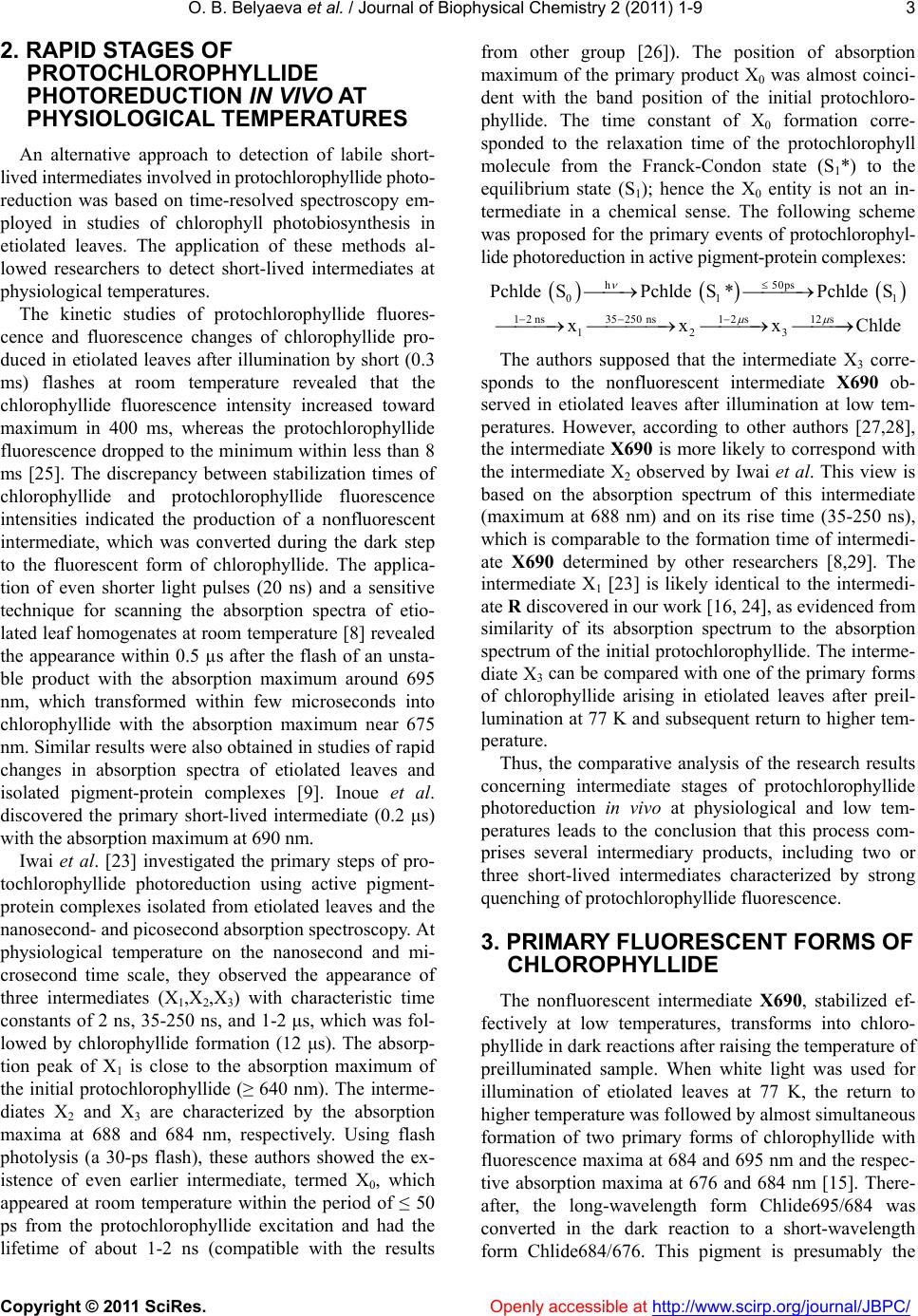 O. B. Belyaeva et al. / Journal of Biophysical Chemistry 2 (2011) 1-9 Copyright © 2011 SciRes. Openly accessible at http://www.scirp.org/journal/JBPC/ 3 LIDE T S Art- liv otochlorophyllide fluores- ce s of pro- to 2. RAPID STAGES OF PROTOCHLOROPHYL PHOTOREDUCTION IN VIVO A PHYSIOLOGICAL TEMPERATURE n alternative approach to detection of labile sho ed intermediates involved in protochlorophyllide photo- reduction was based on time-resolved spectroscopy em- ployed in studies of chlorophyll photobiosynthesis in etiolated leaves. The application of these methods al- lowed researchers to detect short-lived intermediates at physiological temperatures. The kinetic studies of pr nce and fluorescence changes of chlorophyllide pro- duced in etiolated leaves after illumination by short (0.3 ms) flashes at room temperature revealed that the chlorophyllide fluorescence intensity increased toward maximum in 400 ms, whereas the protochlorophyllide fluorescence dropped to the minimum within less than 8 ms [25]. The discrepancy between stabilization times of chlorophyllide and protochlorophyllide fluorescence intensities indicated the production of a nonfluorescent intermediate, which was converted during the dark step to the fluorescent form of chlorophyllide. The applica- tion of even shorter light pulses (20 ns) and a sensitive technique for scanning the absorption spectra of etio- lated leaf homogenates at room temperature [8] revealed the appearance within 0.5 µs after the flash of an unsta- ble product with the absorption maximum around 695 nm, which transformed within few microseconds into chlorophyllide with the absorption maximum near 675 nm. Similar results were also obtained in studies of rapid changes in absorption spectra of etiolated leaves and isolated pigment-protein complexes [9]. Inoue et al. discovered the primary short-lived intermediate (0.2 μs) with the absorption maximum at 690 nm. Iwai et al. [23] investigated the primary step chlorophyllide photoreduction using active pigment- protein complexes isolated from etiolated leaves and the nanosecond- and picosecond absorption spectroscopy. At physiological temperature on the nanosecond and mi- crosecond time scale, they observed the appearance of three intermediates (X1,X2,X3) with characteristic time constants of 2 ns, 35-250 ns, and 1-2 μs, which was fol- lowed by chlorophyllide formation (12 μs). The absorp- tion peak of X1 is close to the absorption maximum of the initial protochlorophyllide (≥ 640 nm). The interme- diates X2 and X3 are characterized by the absorption maxima at 688 and 684 nm, respectively. Using flash photolysis (a 30-ps flash), these authors showed the ex- istence of even earlier intermediate, termed X0, which appeared at room temperature within the period of ≤ 50 ps from the protochlorophyllide excitation and had the lifetime of about 1-2 ns (compatible with the results from other group [26]). The position of absorption maximum of the primary product X0 was almost coinci- dent with the band position of the initial protochloro- phyllide. The time constant of X0 formation corre- sponded to the relaxation time of the protochlorophyll molecule from the Franck-Condon state (S1*) to the equilibrium state (S1); hence the X0 entity is not an in- termediate in a chemical sense. The following scheme was proposed for the primary events of protochlorophyl- lide photoreduction in active pigment-protein complexes: ) () ) h 50ps Pchlde SPchlde S*Pchlde S ν ≤ ⎯⎯→ ⎯⎯⎯→ 01 12 ns35250 ns12s12s 123 xxx Chlde μμ −− − ⎯⎯⎯→ ⎯⎯⎯⎯→⎯⎯⎯→⎯⎯⎯→ 1 The authors supposed that the intermediate X3 corr sp e comparative analysis of the research results co 3. PRIMARY FLUORESCENT FORMS OF TX690, stabilized ef- fe e- onds to the nonfluorescent intermediate X690 ob- served in etiolated leaves after illumination at low tem- peratures. However, according to other authors [27,28], the intermediate X690 is more likely to correspond with the intermediate X2 observed by Iwai et al. This view is based on the absorption spectrum of this intermediate (maximum at 688 nm) and on its rise time (35-250 ns), which is comparable to the formation time of intermedi- ate X690 determined by other researchers [8,29]. The intermediate X1 [23] is likely identical to the intermedi- ate R discovered in our work [16, 24], as evidenced from similarity of its absorption spectrum to the absorption spectrum of the initial protochlorophyllide. The interme- diate X3 can be compared with one of the primary forms of chlorophyllide arising in etiolated leaves after preil- lumination at 77 K and subsequent return to higher tem- perature. Thus, th ncerning intermediate stages of protochlorophyllide photoreduction in vivo at physiological and low tem- peratures leads to the conclusion that this process com- prises several intermediary products, including two or three short-lived intermediates characterized by strong quenching of protochlorophyllide fluorescence. CHLOROPHYLLIDE he nonfluorescent intermediate ctively at low temperatures, transforms into chloro- phyllide in dark reactions after raising the temperature of preilluminated sample. When white light was used for illumination of etiolated leaves at 77 K, the return to higher temperature was followed by almost simultaneous formation of two primary forms of chlorophyllide with fluorescence maxima at 684 and 695 nm and the respec- tive absorption maxima at 676 and 684 nm [15]. There- after, the long-wavelength form Chlide695/684 was converted in the dark reaction to a short-wavelength form Chlide684/676. This pigment is presumably the 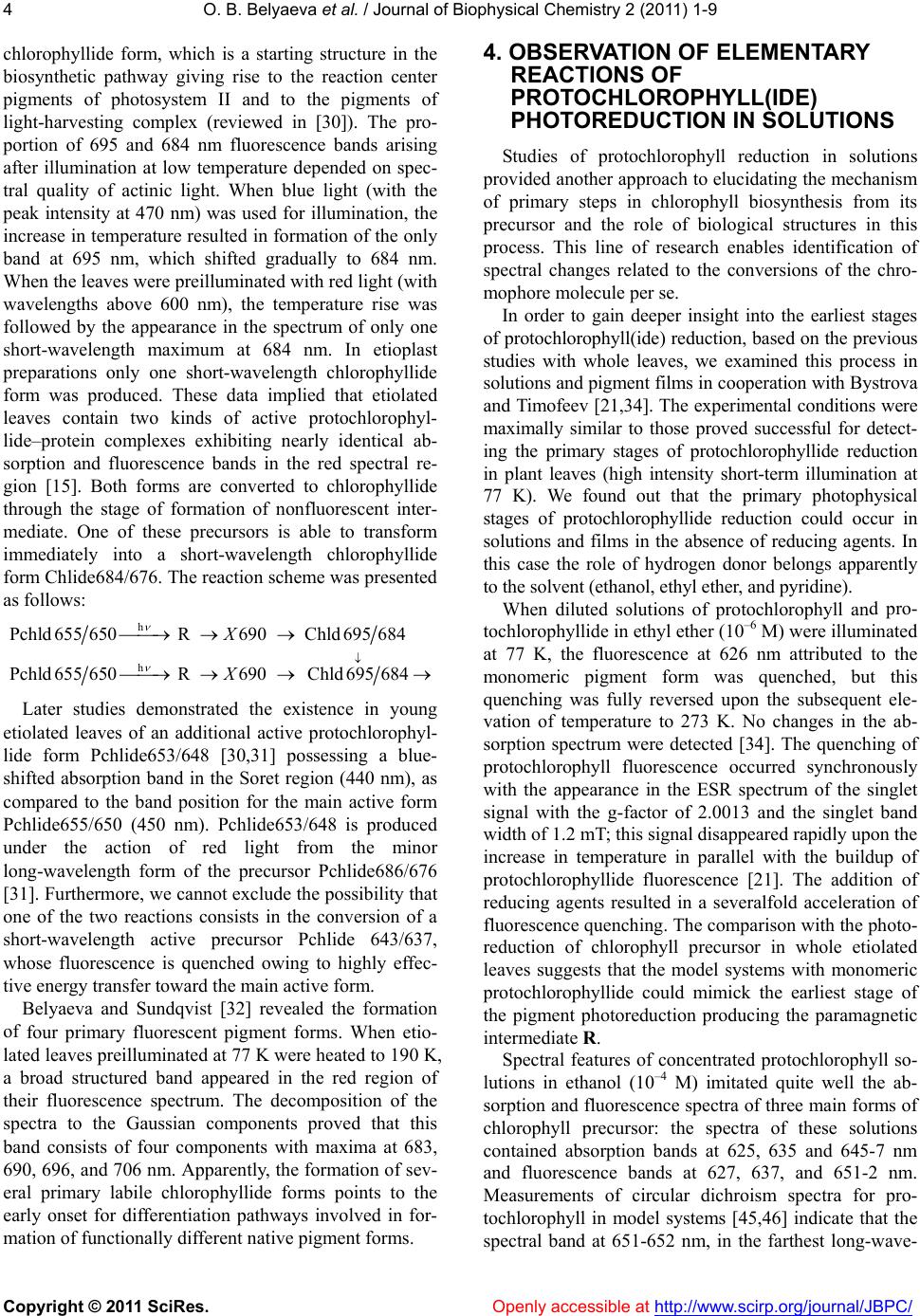 O. B. Belyaeva et al. / Journal of Biophysical Chemistry 2 (2011) 1-9 Copyright © 2011 SciRes. Openly accessible at http://www.scirp.org/journal/JBPC/ 4 chlorophyllide form, which is a starting structure in the biosynthetic pathway giving rise to the reaction center pigments of photosystem II and to the pigments of light-harvesting complex (reviewed in [30]). The pro- portion of 695 and 684 nm fluorescence bands arising after illumination at low temperature depended on spec- tral quality of actinic light. When blue light (with the peak intensity at 470 nm) was used for illumination, the increase in temperature resulted in formation of the only band at 695 nm, which shifted gradually to 684 nm. When the leaves were preilluminated with red light (with wavelengths above 600 nm), the temperature rise was followed by the appearance in the spectrum of only one short-wavelength maximum at 684 nm. In etioplast preparations only one short-wavelength chlorophyllide form was produced. These data implied that etiolated leaves contain two kinds of active protochlorophyl- lide–protein complexes exhibiting nearly identical ab- sorption and fluorescence bands in the red spectral re- gion [15]. Both forms are converted to chlorophyllide through the stage of formation of nonfluorescent inter- mediate. One of these precursors is able to transform immediately into a short-wavelength chlorophyllide form Chlide684/676. The reaction scheme was presented as follows: h h Pchld655650 R 690 Chld695684 Pchld655650 R 690 Chld695684 Х Х ν ν ↓ ⎯⎯→→ → ⎯→→ →→ Later studies demonstrated the existence in young et mation of HYLL(IDE) ONS S pr insight into the earliest stages of d pro- to es of concentrated protochlorophyll so- lu iolated leaves of an additional active protochlorophyl- lide form Pchlide653/648 [30,31] possessing a blue- shifted absorption band in the Soret region (440 nm), as compared to the band position for the main active form Pchlide655/650 (450 nm). Pchlide653/648 is produced under the action of red light from the minor long-wavelength form of the precursor Pchlide686/676 [31]. Furthermore, we cannot exclude the possibility that one of the two reactions consists in the conversion of a short-wavelength active precursor Pchlide 643/637, whose fluorescence is quenched owing to highly effec- tive energy transfer toward the main active form. Belyaeva and Sundqvist [32] revealed the for four primary fluorescent pigment forms. When etio- lated leaves preilluminated at 77 K were heated to 190 K, a broad structured band appeared in the red region of their fluorescence spectrum. The decomposition of the spectra to the Gaussian components proved that this band consists of four components with maxima at 683, 690, 696, and 706 nm. Apparently, the formation of sev- eral primary labile chlorophyllide forms points to the early onset for differentiation pathways involved in for- mation of functionally different native pigment forms. 4. OBSERVATION OF ELEMENTARY REACTIONS OF PROTOCHLOROP PHOTORE DUCTION IN SOLUTI tudies of protochlorophyll reduction in solutions ovided another approach to elucidating the mechanism of primary steps in chlorophyll biosynthesis from its precursor and the role of biological structures in this process. This line of research enables identification of spectral changes related to the conversions of the chro- mophore molecule per se. In order to gain deeper protochlorophyll(ide) reduction, based on the previous studies with whole leaves, we examined this process in solutions and pigment films in cooperation with Bystrova and Timofeev [21,34]. The experimental conditions were maximally similar to those proved successful for detect- ing the primary stages of protochlorophyllide reduction in plant leaves (high intensity short-term illumination at 77 K). We found out that the primary photophysical stages of protochlorophyllide reduction could occur in solutions and films in the absence of reducing agents. In this case the role of hydrogen donor belongs apparently to the solvent (ethanol, ethyl ether, and pyridine). When diluted solutions of protochlorophyll an chlorophyllide in ethyl ether (10–6 M) were illuminated at 77 K, the fluorescence at 626 nm attributed to the monomeric pigment form was quenched, but this quenching was fully reversed upon the subsequent ele- vation of temperature to 273 K. No changes in the ab- sorption spectrum were detected [34]. The quenching of protochlorophyll fluorescence occurred synchronously with the appearance in the ESR spectrum of the singlet signal with the g-factor of 2.0013 and the singlet band width of 1.2 mT; this signal disappeared rapidly upon the increase in temperature in parallel with the buildup of protochlorophyllide fluorescence [21]. The addition of reducing agents resulted in a severalfold acceleration of fluorescence quenching. The comparison with the photo- reduction of chlorophyll precursor in whole etiolated leaves suggests that the model systems with monomeric protochlorophyllide could mimick the earliest stage of the pigment photoreduction producing the paramagnetic intermediate R. Spectral featur tions in ethanol (10–4 M) imitated quite well the ab- sorption and fluorescence spectra of three main forms of chlorophyll precursor: the spectra of these solutions contained absorption bands at 625, 635 and 645-7 nm and fluorescence bands at 627, 637, and 651-2 nm. Measurements of circular dichroism spectra for pro- tochlorophyll in model systems [45,46] indicate that the spectral band at 651-652 nm, in the farthest long-wave- 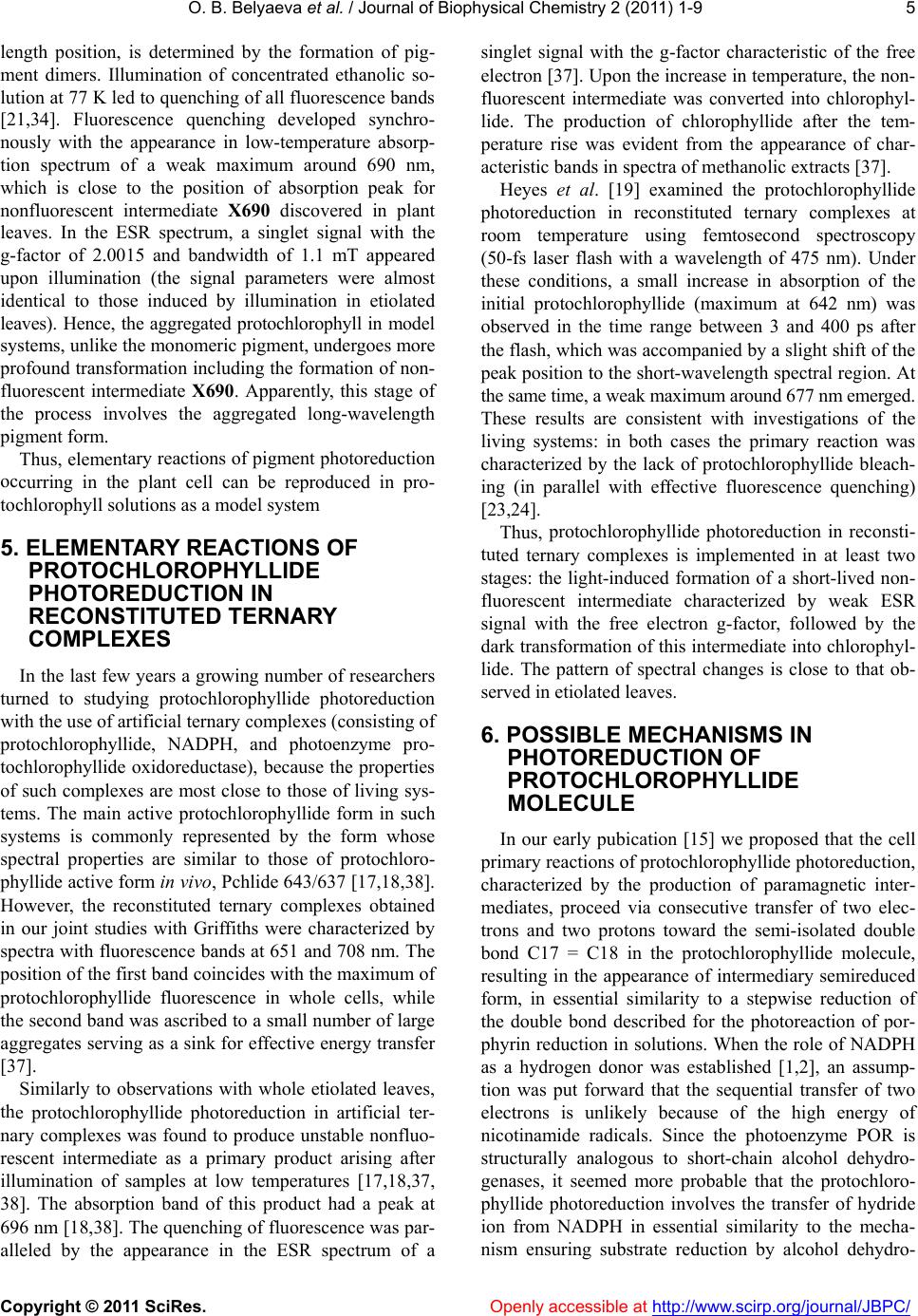 O. B. Belyaeva et al. / Journal of Biophysical Chemistry 2 (2011) 1-9 Copyright © 2011 SciRes. Openly accessible at http://www.scirp.org/journal/JBPC/ 5 tary reactions of pigment photoreduction oc 5. ELEMENTARY REACTIONS OF RY Ia growing number of researchers tu arly to observations with whole etiolated leaves, th ph protochlorophyllide photoreduction in reconsti- tu 6. POSSIBLE MECHANISMS IN E Ition [15] we proposed that the cell pr length position, is determined by the formation of pig- ment dimers. Illumination of concentrated ethanolic so- lution at 77 K led to quenching of all fluorescence bands [21,34]. Fluorescence quenching developed synchro- nously with the appearance in low-temperature absorp- tion spectrum of a weak maximum around 690 nm, which is close to the position of absorption peak for nonfluorescent intermediate X690 discovered in plant leaves. In the ESR spectrum, a singlet signal with the g-factor of 2.0015 and bandwidth of 1.1 mT appeared upon illumination (the signal parameters were almost identical to those induced by illumination in etiolated leaves). Hence, the aggregated protochlorophyll in model systems, unlike the monomeric pigment, undergoes more profound transformation including the formation of non- fluorescent intermediate X690. Apparently, this stage of the process involves the aggregated long-wavelength pigment form. Thus, elemen curring in the plant cell can be reproduced in pro- tochlorophyll solutions as a model system PROTOCHLOROPHYLLIDE PHOTORE DUCTION IN RECONSTITUTED TERNA COMPLEXES n the last few years rned to studying protochlorophyllide photoreduction with the use of artificial ternary complexes (consisting of protochlorophyllide, NADPH, and photoenzyme pro- tochlorophyllide oxidoreductase), because the properties of such complexes are most close to those of living sys- tems. The main active protochlorophyllide form in such systems is commonly represented by the form whose spectral properties are similar to those of protochloro- phyllide active form in vivo, Pchlide 643/637 [17,18,38]. However, the reconstituted ternary complexes obtained in our joint studies with Griffiths were characterized by spectra with fluorescence bands at 651 and 708 nm. The position of the first band coincides with the maximum of protochlorophyllide fluorescence in whole cells, while the second band was ascribed to a small number of large aggregates serving as a sink for effective energy transfer [37]. Simil e protochlorophyllide photoreduction in artificial ter- nary complexes was found to produce unstable nonfluo- rescent intermediate as a primary product arising after illumination of samples at low temperatures [17,18,37, 38]. The absorption band of this product had a peak at 696 nm [18,38]. The quenching of fluorescence was par- alleled by the appearance in the ESR spectrum of a singlet signal with the g-factor characteristic of the free electron [37]. Upon the increase in temperature, the non- fluorescent intermediate was converted into chlorophyl- lide. The production of chlorophyllide after the tem- perature rise was evident from the appearance of char- acteristic bands in spectra of methanolic extracts [37]. Heyes et al. [19] examined the protochlorophyllide otoreduction in reconstituted ternary complexes at room temperature using femtosecond spectroscopy (50-fs laser flash with a wavelength of 475 nm). Under these conditions, a small increase in absorption of the initial protochlorophyllide (maximum at 642 nm) was observed in the time range between 3 and 400 ps after the flash, which was accompanied by a slight shift of the peak position to the short-wavelength spectral region. At the same time, a weak maximum around 677 nm emerged. These results are consistent with investigations of the living systems: in both cases the primary reaction was characterized by the lack of protochlorophyllide bleach- ing (in parallel with effective fluorescence quenching) [23,24]. Thus, ted ternary complexes is implemented in at least two stages: the light-induced formation of a short-lived non- fluorescent intermediate characterized by weak ESR signal with the free electron g-factor, followed by the dark transformation of this intermediate into chlorophyl- lide. The pattern of spectral changes is close to that ob- served in etiolated leaves. PHOTORE DUCTION OF PROTOCHLOROPHYLLID MOLECULE n our early pubica imary reactions of protochlorophyllide photoreduction, characterized by the production of paramagnetic inter- mediates, proceed via consecutive transfer of two elec- trons and two protons toward the semi-isolated double bond C17 = C18 in the protochlorophyllide molecule, resulting in the appearance of intermediary semireduced form, in essential similarity to a stepwise reduction of the double bond described for the photoreaction of por- phyrin reduction in solutions. When the role of NADPH as a hydrogen donor was established [1,2], an assump- tion was put forward that the sequential transfer of two electrons is unlikely because of the high energy of nicotinamide radicals. Since the photoenzyme POR is structurally analogous to short-chain alcohol dehydro- genases, it seemed more probable that the protochloro- phyllide photoreduction involves the transfer of hydride ion from NADPH in essential similarity to the mecha- nism ensuring substrate reduction by alcohol dehydro- 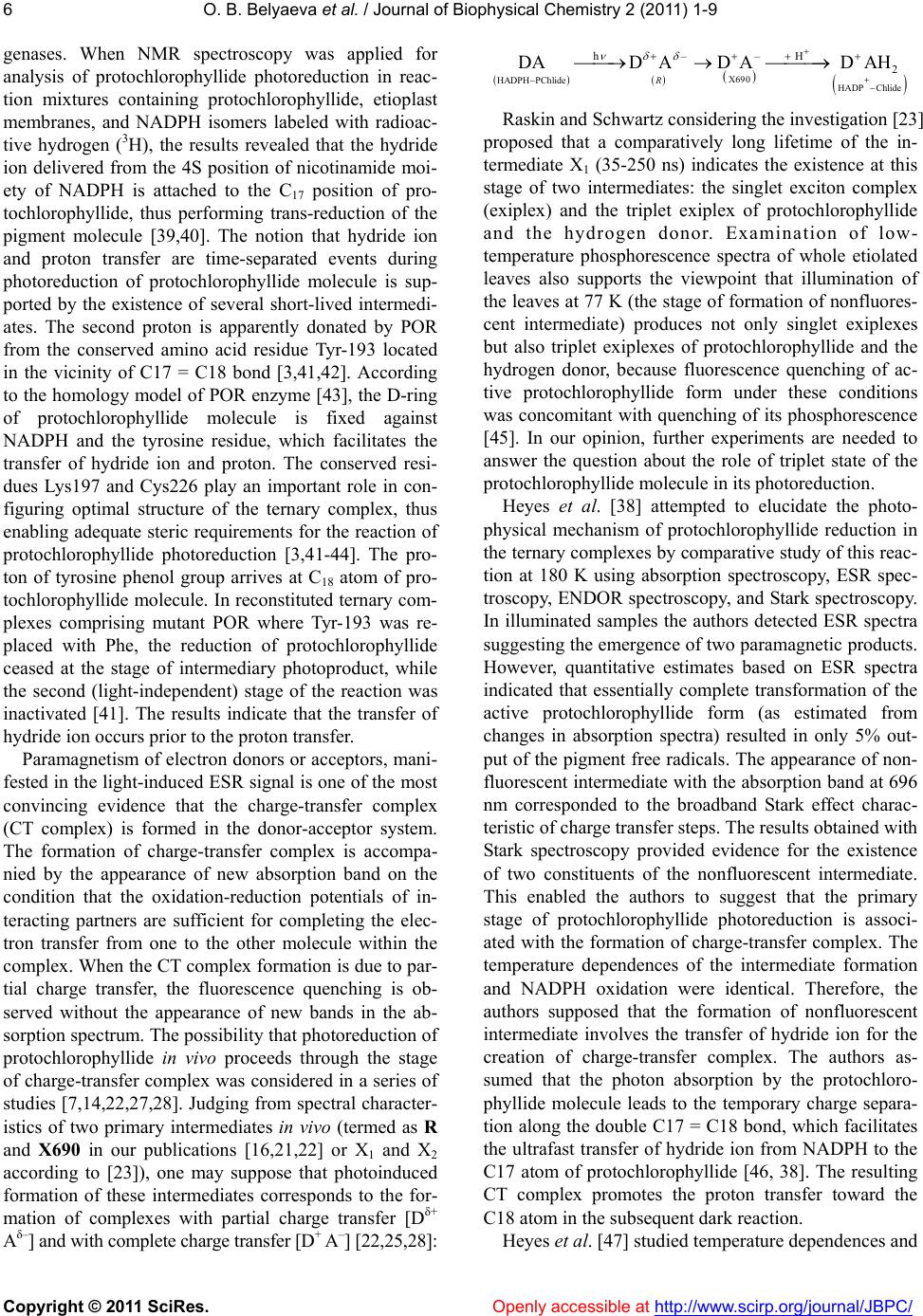 O. B. Belyaeva et al. / Journal of Biophysical Chemistry 2 (2011) 1-9 Copyright © 2011 SciRes. Openly accessible at http://www.scirp.org/journal/JBPC/ 6 s, mani- fe Raskin and Schwartz considering the investigation [23] pr ph genases. When NMR spectroscopy was applied for analysis of protochlorophyllide photoreduction in reac- tion mixtures containing protochlorophyllide, etioplast membranes, and NADPH isomers labeled with radioac- tive hydrogen (3H), the results revealed that the hydride ion delivered from the 4S position of nicotinamide moi- ety of NADPH is attached to the C17 position of pro- tochlorophyllide, thus performing trans-reduction of the pigment molecule [39,40]. The notion that hydride ion and proton transfer are time-separated events during photoreduction of protochlorophyllide molecule is sup- ported by the existence of several short-lived intermedi- ates. The second proton is apparently donated by POR from the conserved amino acid residue Tyr-193 located in the vicinity of C17 = C18 bond [3,41,42]. According to the homology model of POR enzyme [43], the D-ring of protochlorophyllide molecule is fixed against NADPH and the tyrosine residue, which facilitates the transfer of hydride ion and proton. The conserved resi- dues Lys197 and Cys226 play an important role in con- figuring optimal structure of the ternary complex, thus enabling adequate steric requirements for the reaction of protochlorophyllide photoreduction [3,41-44]. The pro- ton of tyrosine phenol group arrives at C18 atom of pro- tochlorophyllide molecule. In reconstituted ternary com- plexes comprising mutant POR where Tyr-193 was re- placed with Phe, the reduction of protochlorophyllide ceased at the stage of intermediary photoproduct, while the second (light-independent) stage of the reaction was inactivated [41]. The results indicate that the transfer of hydride ion occurs prior to the proton transfer. Paramagnetism of electron donors or acceptor sted in the light-induced ESR signal is one of the most convincing evidence that the charge-transfer complex (CT complex) is formed in the donor-acceptor system. The formation of charge-transfer complex is accompa- nied by the appearance of new absorption band on the condition that the oxidation-reduction potentials of in- teracting partners are sufficient for completing the elec- tron transfer from one to the other molecule within the complex. When the CT complex formation is due to par- tial charge transfer, the fluorescence quenching is ob- served without the appearance of new bands in the ab- sorption spectrum. The possibility that photoreduction of protochlorophyllide in vivo proceeds through the stage of charge-transfer complex was considered in a series of studies [7,14,22,27,28]. Judging from spectral character- istics of two primary intermediates in vivo (termed as R and X690 in our publications [16,21,22] or X1 and X2 according to [23]), one may suppose that photoinduced formation of these intermediates corresponds to the for- mation of complexes with partial charge transfer [Dδ+ Aδ–] and with complete charge transfer [D+ A–] [22,25,28]: h H –– 2 DADAD ADAH νδδ + + ++ + ⎯⎯→→⎯⎯⎯→ () () () () X690 HADPHPChlideHADP Chlide R+ −− oposed that a comparatively long lifetime of the in- termediate X1 (35-250 ns) indicates the existence at this stage of two intermediates: the singlet exciton complex (exiplex) and the triplet exiplex of protochlorophyllide and the hydrogen donor. Examination of low- temperature phosphorescence spectra of whole etiolated leaves also supports the viewpoint that illumination of the leaves at 77 K (the stage of formation of nonfluores- cent intermediate) produces not only singlet exiplexes but also triplet exiplexes of protochlorophyllide and the hydrogen donor, because fluorescence quenching of ac- tive protochlorophyllide form under these conditions was concomitant with quenching of its phosphorescence [45]. In our opinion, further experiments are needed to answer the question about the role of triplet state of the protochlorophyllide molecule in its photoreduction. Heyes et al. [38] attempted to elucidate the photo- ysical mechanism of protochlorophyllide reduction in the ternary complexes by comparative study of this reac- tion at 180 K using absorption spectroscopy, ESR spec- troscopy, ENDOR spectroscopy, and Stark spectroscopy. In illuminated samples the authors detected ESR spectra suggesting the emergence of two paramagnetic products. However, quantitative estimates based on ESR spectra indicated that essentially complete transformation of the active protochlorophyllide form (as estimated from changes in absorption spectra) resulted in only 5% out- put of the pigment free radicals. The appearance of non- fluorescent intermediate with the absorption band at 696 nm corresponded to the broadband Stark effect charac- teristic of charge transfer steps. The results obtained with Stark spectroscopy provided evidence for the existence of two constituents of the nonfluorescent intermediate. This enabled the authors to suggest that the primary stage of protochlorophyllide photoreduction is associ- ated with the formation of charge-transfer complex. The temperature dependences of the intermediate formation and NADPH oxidation were identical. Therefore, the authors supposed that the formation of nonfluorescent intermediate involves the transfer of hydride ion for the creation of charge-transfer complex. The authors as- sumed that the photon absorption by the protochloro- phyllide molecule leads to the temporary charge separa- tion along the double C17 = C18 bond, which facilitates the ultrafast transfer of hydride ion from NADPH to the C17 atom of protochlorophyllide [46, 38]. The resulting CT complex promotes the proton transfer toward the C18 atom in the subsequent dark reaction. Heyes et al. [47] studied temperature dependences and 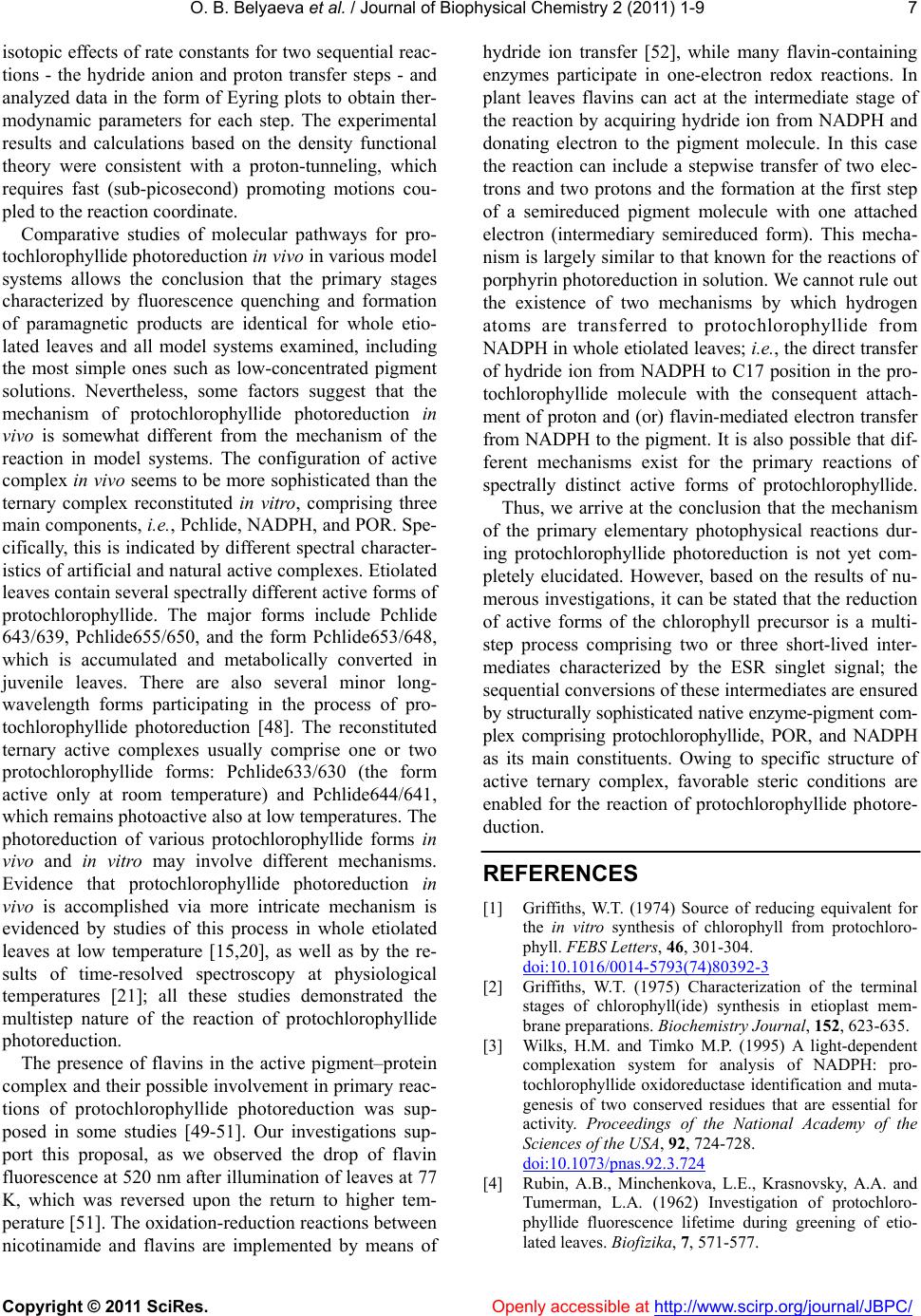 O. B. Belyaeva et al. / Journal of Biophysical Chemistry 2 (2011) 1-9 Copyright © 2011 SciRes. Openly accessible at http://www.scirp.org/journal/JBPC/ 7 is ular pathways for pro- to flavins in the active pigment–protein co of 74) Source of reducing equivalent for 3 otopic effects of rate constants for two sequential reac- tions - the hydride anion and proton transfer steps - and analyzed data in the form of Eyring plots to obtain ther- modynamic parameters for each step. The experimental results and calculations based on the density functional theory were consistent with a proton-tunneling, which requires fast (sub-picosecond) promoting motions cou- pled to the reaction coordinate. Comparative studies of molec chlorophyllide photoreduction in vivo in various model systems allows the conclusion that the primary stages characterized by fluorescence quenching and formation of paramagnetic products are identical for whole etio- lated leaves and all model systems examined, including the most simple ones such as low-concentrated pigment solutions. Nevertheless, some factors suggest that the mechanism of protochlorophyllide photoreduction in vivo is somewhat different from the mechanism of the reaction in model systems. The configuration of active complex in vivo seems to be more sophisticated than the ternary complex reconstituted in vitro, comprising three main components, i.e., Pchlide, NADPH, and POR. Spe- cifically, this is indicated by different spectral character- istics of artificial and natural active complexes. Etiolated leaves contain several spectrally different active forms of protochlorophyllide. The major forms include Pchlide 643/639, Pchlide655/650, and the form Pchlide653/648, which is accumulated and metabolically converted in juvenile leaves. There are also several minor long- wavelength forms participating in the process of pro- tochlorophyllide photoreduction [48]. The reconstituted ternary active complexes usually comprise one or two protochlorophyllide forms: Pchlide633/630 (the form active only at room temperature) and Pchlide644/641, which remains photoactive also at low temperatures. The photoreduction of various protochlorophyllide forms in vivo and in vitro may involve different mechanisms. Evidence that protochlorophyllide photoreduction in vivo is accomplished via more intricate mechanism is evidenced by studies of this process in whole etiolated leaves at low temperature [15,20], as well as by the re- sults of time-resolved spectroscopy at physiological temperatures [21]; all these studies demonstrated the multistep nature of the reaction of protochlorophyllide photoreduction. The presence of mplex and their possible involvement in primary reac- tions of protochlorophyllide photoreduction was sup- posed in some studies [49-51]. Our investigations sup- port this proposal, as we observed the drop of flavin fluorescence at 520 nm after illumination of leaves at 77 K, which was reversed upon the return to higher tem- perature [51]. The oxidation-reduction reactions between nicotinamide and flavins are implemented by means of hydride ion transfer [52], while many flavin-containing enzymes participate in one-electron redox reactions. In plant leaves flavins can act at the intermediate stage of the reaction by acquiring hydride ion from NADPH and donating electron to the pigment molecule. In this case the reaction can include a stepwise transfer of two elec- trons and two protons and the formation at the first step of a semireduced pigment molecule with one attached electron (intermediary semireduced form). This mecha- nism is largely similar to that known for the reactions of porphyrin photoreduction in solution. We cannot rule out the existence of two mechanisms by which hydrogen atoms are transferred to protochlorophyllide from NADPH in whole etiolated leaves; i.e. , the direct transfer of hydride ion from NADPH to C17 position in the pro- tochlorophyllide molecule with the consequent attach- ment of proton and (or) flavin-mediated electron transfer from NADPH to the pigment. It is also possible that dif- ferent mechanisms exist for the primary reactions of spectrally distinct active forms of protochlorophyllide. Thus, we arrive at the conclusion that the mechanism the primary elementary photophysical reactions dur- ing protochlorophyllide photoreduction is not yet com- pletely elucidated. However, based on the results of nu- merous investigations, it can be stated that the reduction of active forms of the chlorophyll precursor is a multi- step process comprising two or three short-lived inter- mediates characterized by the ESR singlet signal; the sequential conversions of these intermediates are ensured by structurally sophisticated native enzyme-pigment com- plex comprising protochlorophyllide, POR, and NADPH as its main constituents. Owing to specific structure of active ternary complex, favorable steric conditions are enabled for the reaction of protochlorophyllide photore- duction. REFERENCES [1] Griffiths, W.T. (19 the in vitro synthesis of chlorophyll from protochloro- phyll. FEBS Letters, 46, 301-304. doi:10.1016/0014-5793(74)80392- of the terminal [2] Griffiths, W.T. (1975) Сharacterization stages of chlorophyll(ide) synthesis in etioplast mem- brane preparations. Biochemistry Journal, 152, 623-635. [3] Wilks, H.M. and Timko M.P. (1995) A light-dependent complexation system for analysis of NADPH: pro- tochlorophyllide oxidoreductase identification and muta- genesis of two conserved residues that are essential for activity. Proceedings of the National Academy of the Sciences of the USA, 92, 724-728. doi:10.1073/pnas.92.3.724 [4] Rubin, A.B., Minchenkova, L.E., Krasnovsky, A.A. and Tumerman, L.A. (1962) Investigation of protochloro- phyllide fluorescence lifetime during greening of etio- lated leaves. Biofizika, 7, 571-577. 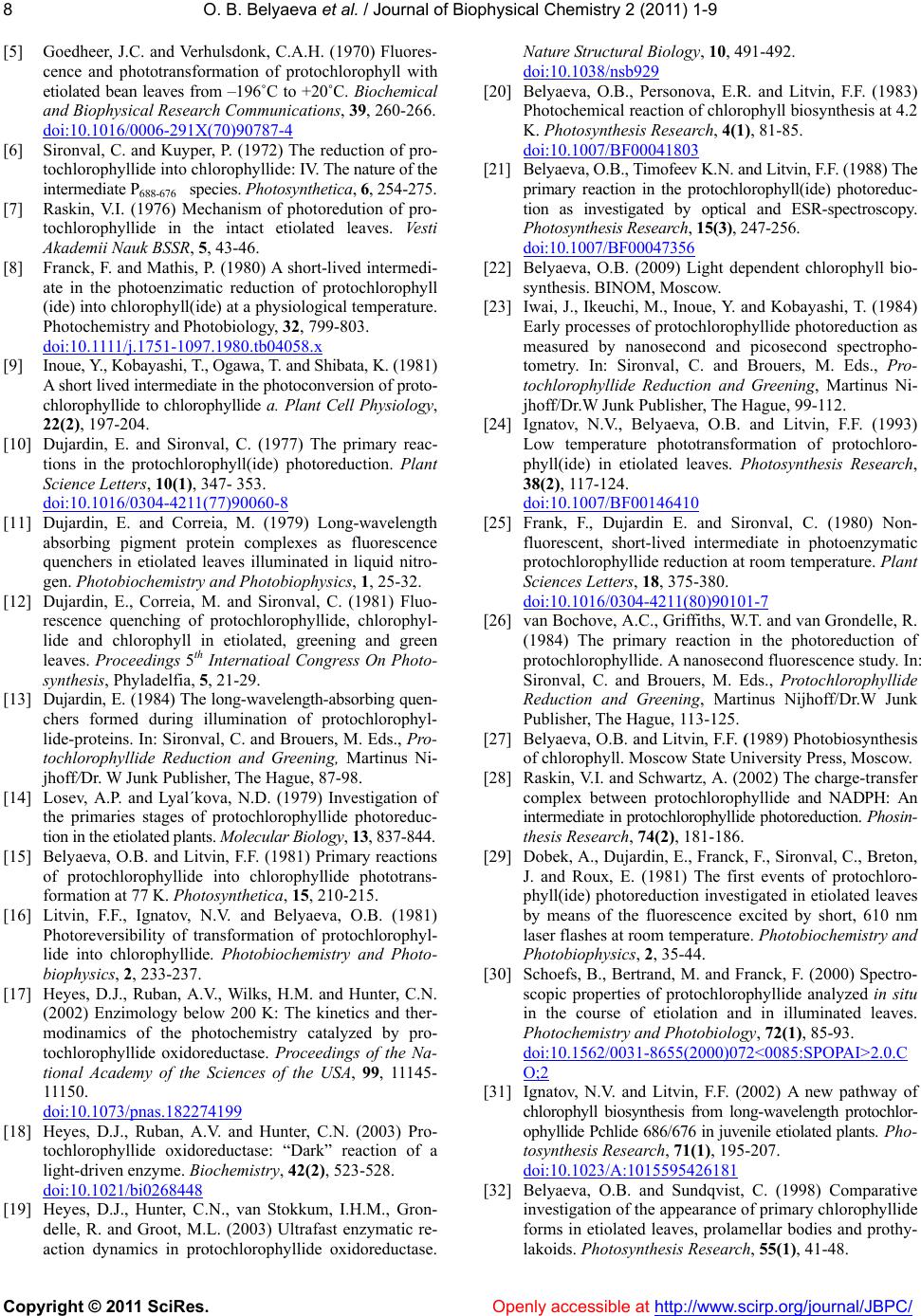 O. B. Belyaeva et al. / Journal of Biophysical Chemistry 2 (2011) 1-9 Copyright © 2011 SciRes. Openly accessible at http://www.scirp.org/journal/JBPC/ 8 .A.H. (1970) Fluores-[5] Goedheer, J.C. and Verhulsdonk, C cence and phototransformation of protochlorophyll with etiolated bean leaves from –196˚C to +20˚C. Biochemical and Biophysical Research Communications, 39, 260-266. doi:10.1016/0006-291X(70)90787-4 [6] Sironval, C. and Kuyper, P. (1972) The reduction of pro- A short-lived intermedi- tochlorophyllide into chlorophyllide: IV. The nature of the intermediate P688-676 species. Photosynthetica, 6, 254-275. [7] Raskin, V.I. (1976) Mechanism of photoredution of pro- tochlorophyllide in the intact etiolated leaves. Ve st i Akademii Nauk BSSR, 5, 43-46. [8] Franck, F. and Mathis, P. (1980) ate in the photoenzimatic reduction of protochlorophyll (ide) into chlorophyll(ide) at a physiological temperature. Photochemistry and Photobiology, 32, 799-803. doi:10.1111/j.1751-1097.1980.tb04058.x [9] Inoue, Y., Kobayashi, T., Ogawa, T. and Shibata, K. (1981) 1977) The primary r -8 A short lived intermediate in the photoconversion of proto- chlorophyllide to chlorophyllide a. Plant Cell Physiology, 22(2), 197-204. [10] Dujardin, E. and Sironval, C. (eac- tions in the protochlorophyll(ide) photoreduction. Plant Science Letters, 10(1), 347- 353. doi:10.1016/0304-4211(77)90060 ) Long-wavelength - bsorbing quen- igation (1981) ., Wilks, H.M. and Hunter, C. 073/pnas.182274199 [11] Dujardin, E. and Correia, M. (1979 absorbing pigment protein complexes as fluorescence quenchers in etiolated leaves illuminated in liquid nitro- gen. Photobiochemistry and Photobiophysics, 1, 25-32. [12] Dujardin, E., Correia, M. and Sironval, C. (1981) Fluo rescence quenching of protochlorophyllide, chlorophyl- lide and chlorophyll in etiolated, greening and green leaves. Proceedings 5th Internatioal Congress On Photo- synthesis, Phyladelfia, 5, 21-29. [13] Dujardin, E. (1984) The long-wavelength-a chers formed during illumination of protochlorophyl- lide-proteins. In: Sironval, C. and Brouers, M. Eds., Pro- tochlorophyllide Reduction and Greening, Martinus Ni- jhoff/Dr. W Junk Publisher, The Hague, 87-98. [14] Losev, A.P. and Lyal´kova, N.D. (1979) Invest of the primaries stages of protochlorophyllide photoreduc- tion in the etiolated plants. Molecular Biology, 13, 837-844. [15] Belyaeva, O.B. and Litvin, F.F. (1981) Primary reactions of protochlorophyllide into chlorophyllide phototrans- formation at 77 K. Photosynthetica, 15, 210-215. [16] Litvin, F.F., Ignatov, N.V. and Belyaeva, O.B. Photoreversibility of transformation of protochlorophyl- lide into chlorophyllide. Photobiochemistry and Photo- biophysics, 2, 233-237. [17] Heyes, D.J., Ruban, A.VN. (2002) Enzimology below 200 K: The kinetics and ther- modinamics of the photochemistry catalyzed by pro- tochlorophyllide oxidoreductase. Proceedings of the Na- tional Academy of the Sciences of the USA, 99, 11145- 11150. doi:10.1 Hunter, C.N. (2003) Pro-[18] Heyes, D.J., Ruban, A.V. and tochlorophyllide oxidoreductase: “Dark” reaction of a light-driven enzyme. Biochemistry, 42(2), 523-528. doi:10.1021/bi0268448 [19] Heyes, D.J., Hunter, C.N., van Stokkum, I.H.M., Gron- delle, R. and Groot, M.L. (2003) Ultrafast enzymatic re- action dynamics in protochlorophyllide oxidoreductase. Nature Structural Biology, 10, 491-492. doi:10.1038/nsb929 [20] Belyaeva, O.B., Personova, E.R. and Litvin, F.F. (1983) Photochemical reaction of chlorophyll biosynthesis at 4.2 K. Photosynthesis Research, 4(1), 81-85. doi:10.1007/BF00041803 [21] Belyaeva, O.B., Timofeev K.N. and Litvin, F.F. (1988) The primary reaction in the protochlorophyll(ide) photoreduc- tion as investigated by optical and ESR-spectroscopy. Photosynthesis Research, 15(3), 247-256. doi:10.1007/BF00047 356 [22] Belyaeva, O.B. (2009) Light dependent chlorophyll bio- . and Kobayashi, T. (1984) . (1993) 0146410 synthesis. BINOM, Moscow. [23] Iwai, J., Ikeuchi, M., Inoue, Y Early processes of protochlorophyllide photoreduction as measured by nanosecond and picosecond spectropho- tometry. In: Sironval, C. and Brouers, M. Eds., Pro- tochlorophyllide Reduction and Greening, Martinus Ni- jhoff/Dr.W Junk Publisher, The Hague, 99-112. [24] Ignatov, N.V., Belyaeva, O.B. and Litvin, F.F Low temperature phototransformation of protochloro- phyll(ide) in etiolated leaves. Photosynthesis Research, 38(2), 117-124. doi:10.1007/BF0 d Sironval, C. (1980) Non- 1-7 [25] Frank, F., Dujardin E. an fluorescent, short-lived intermediate in photoenzymatic protochlorophyllide reduction at room temperature. Plant Sciences Letters, 18, 375-380. doi:10.1016/0304-4211(80)9010 d van Grondelle, R. 1989) Photobiosynthesis F., Sironval, C., Breton, d Franck, F. (2000) Spectro- 2.0.C [26] van Bochove, A.C., Griffiths, W.T. an (1984) The primary reaction in the photoreduction of protochlorophyllide. A nanosecond fluorescence study. In: Sironval, C. and Brouers, M. Eds., Protochlorophyllide Reduction and Greening, Martinus Nijhoff/Dr.W Junk Publisher, The Hague, 113-125. [27] Belyaeva, O.B. and Litvin, F.F. ( of chlorophyll. Moscow State University Press, Moscow. [28] Raskin, V.I. and Schwartz, A. (2002) The charge-transfer complex between protochlorophyllide and NADPH: An intermediate in protochlorophyllide photoreduction. Phosin- thesis Research, 74(2), 181-186. [29] Dobek, A., Dujardin, E., Franck, J. and Roux, E. (1981) The first events of protochloro- phyll(ide) photoreduction investigated in etiolated leaves by means of the fluorescence excited by short, 610 nm laser flashes at room temperature. Photobiochemistry and Photobiophysics, 2, 35-44. [30] Schoefs, B., Bertrand, M. an scopic properties of protochlorophyllide analyzed in situ in the course of etiolation and in illuminated leaves. Photochemistry and Photobiology, 72(1), 85-93. doi:10.1562/0031-8655(2000)072<0085:SPOPAI> O;2 [31] Ignatov, N.V. and Litvin, F.F. (2002) A new pathway of chlorophyll biosynthesis from long-wavelength protochlor- ophyllide Pchlide 686/676 in juvenile etiolated plants. Pho- tosynthesis Research, 71(1), 195-207. doi:10.1023/A:1015595426181 [32] Belyaeva, O.B. and Sundqvist, C. (1998) Comparative investigation of the appearance of primary chlorophyllide forms in etiolated leaves, prolamellar bodies and prothy- lakoids. Photosynthesis Research, 55(1), 41-48.  O. B. Belyaeva et al. / Journal of Biophysical Chemistry 2 (2011) 1-9 Copyright © 2011 SciRes. http://www.scirp.org/journal/JBPC/Openly accessible at 9 doi:10.1023/A:1005974305351 [33] Belyaeva, O.B. and Litvin, F.F. (2009) Pathways of for- .B., Bystrova, M.I., Safronova, I.A., Litvin, vivo aggr yll mation of pigment forms at the terminal photobiochemi- cal stage of chlorophyll biosynthesis. Biochemistry, 74, 1535-1544. [34] Belyaeva, O F.F. and Krasnovsky, A.A. (1985) Photoinduced reversi- ble changes in protochlorophyll fluorescence in model systems. Molecular Biology, 30, 933-938. [35] Brouers, M. (1975) Optical properties of in e- gates of protochlorophyllide in non-polar solvents. II. Fluorescence polarization, delayed fluorescence and cir- cular dichroism spectra. Photosynthetica, 9, 304-310. [36] Böddi, B., Soos, J. and Lang, F. (1980) Protochloroph forms with different molecular arrangements. Biochimica et Biophysica Acta, 593(1), 158-165. doi:10.1016/0005-2728(80)90017-1 [37] Belyaeva, O.B., Griffiths, W.T., Kovalev, J.V., Timofeev, , P., Rigby, S.E.J., Palacios, M.A., K.N. and Litvin, F.F. (2001) Participation of free radicals in photoreduction of protochlorophyllide to chlorophyl- lide in artificial pigment-protein complexes. Biochemis- try, 66(2), 173-177. [38] Heyes, D.J., Heathcote Grondelle, R. and Hunter, C.N. (2006) The first catalytic step of the light-driven enzyme protochlorophyllide oxi- doreductase proceeds via a charge transfer complex. The Journal of Biological Chemistry, 281(37), 26847-26853. doi:10.1074/jbc.M602943200 [39] Valera, V., Fung, M., Wessler, A. N. and Richards, W.R. .1016/0006-291X(87) 9114 1-7 (1987) Synthesis of 4R- and 4S-tritium labeled NADPH for the determination of the coenzyme sterespecificity of NADPH: Protochlorophyllide oxidoreductase. Biochemical and Biophysical Research Communications, 148(1), 515- 520. doi:10 Protochlorophyllide 1 [40] Begley, J.R. and Young, M. (1989) reductase. I. Determination of the regiochemistry and the stereochemistry of the reduction of protochlorophyllide to chlorophyllide. Journal of the American Chemical So- ciety, 111, 3095-3096. doi:10.1021/ja00190a07 ., McIvor, W. and Timko, [41] Lebedev, N., Karginova, OM. (2001) Tyr275 and Lys279 stabilize NADPH within the catalytic site of NADPH: Protochlorophyllide oxidore- ductase and are involved in the formation of the enzyme photoactive state. Biochemistry, 40(42), 12562-12574. doi:10.1021/bi0105025 [42] Menon, B.R.K., Waltho, J.P., Scrutton, N.S. and Heyes, D.J. (2009) Cryogenic and laser photoexitation studies identify multiple roles for active site residues in the light-driven enzyme protochlorophyllide oxidoreductase. Journal of Biologycal Chemistry, 284(27), 18160-18166. doi:10.1074/jbc.M109.020719 [43] Townley, H.E., Sessions, R.B., Clarke, A.R., Dafforn, T.R. and Griffiths, W.T. (2001) Protochlorophyllide oxi- doreductase: A homology model examined by sitedirected mutagenesis. Proteins: Structure, Funktion, and Genetics, Vo l . 44(3), 329-335. doi:10.1002/prot.1098 , P.A., Hunter, C.N., Scrutton N.S. [44] Menon, B.R.K., Davison and Heyes, D.J. (2010) Mutagenesis alters the catalytic mechanism of the light-driven enzyme protochlorophyllide oxidoreductase. Journal of Biologycal Chemistry, 285(3), 2113-2119. doi:10.1074/jbc.M109.071522 a, O.B., Kovalev, Yu.V., ) 793(96)01249-5 [45] Krasnovsky, A.A. Jr., Belyaev Ignatov, N.V. and Litvin, F.F. (1999) Phosphorescence of intermediates of the terminal photochemical stage of chlorophyll biosynthesis. Biochemistry, 64(5), 703-708. [46] Griffiths, W.T., McHugh, T. and Blankenship, R.E. (1996 The light intensity dependence of protochlorophyllide photoreduction and its significance to the catalytic mechanism of protochlorophyllide reductase. FEBS Let- ters, 398, 235-238. doi:10.1016/S0014-5 nd Scrutton, N.S. hotoactive pig- . (1988) Protochlorophyl- 6/0014-5793(88)80929-3 [47] Heyes, D.J., Sakuma, M., Visser, S.P. a (2009) Nuclear quantum tunneling in the light-activated enzyme protochlorophyllide oxidoreductase. Journal of biologibal chemistry, 284(6), 3762-3767. [48] Belyaeva, O.B. and Litvin, F.F. (2007) P ment-enzyme complexes of chlorophyll precursor. Bio- chemistry, 72(13), 1458-1477. [49] Walker, C.J. and Griffiths, W.T lide reductase: A flavoprotein? FEBS Letters, 239(2), 259-262. doi:10.101 Begley, T.P. (1992) [50] Nayar, P., Brun, A., Harriman, A., Mechanistic studies on protochlorophyllide reductase: A model system for the enzymatic reaction. Journal of the Chemical Society, Chemical Communications, 5, 395-397. doi:10.1039/c399200003 95 [51] Ignatov, N.V., Belyaeva, O.B. and Litvin, F.F. (1993) The ide-dependent one-electron 6.tb10634.x possible role of the flavin components of protochloro- phylide-protein complexes in the primary processes of protochlorophyll photoreduction in etiolated plant leaves. Photosynthetica, 29, 235-241. [52] Blenkenhorn, G. (1976) Nicotinam and two-electron (Flavin) oxidoreductation: thermody- namics, kinetics, and mechanism. European Journal of Biochemistry, 67(1), 67-80. doi:10.1111/j.1432-1033.197
|